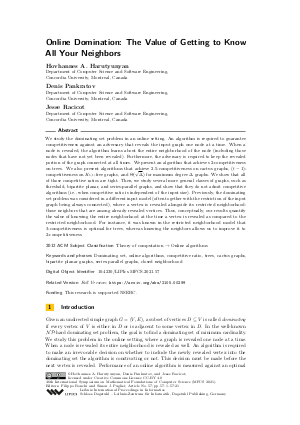Online Domination: The Value of Getting to Know All Your Neighbors
Authors Hovhannes A. Harutyunyan, Denis Pankratov, Jesse Racicot
-
Part of:
Volume:
46th International Symposium on Mathematical Foundations of Computer Science (MFCS 2021)
Part of: Series: Leibniz International Proceedings in Informatics (LIPIcs)
Part of: Conference: Mathematical Foundations of Computer Science (MFCS) - License:
 Creative Commons Attribution 4.0 International license
Creative Commons Attribution 4.0 International license
- Publication Date: 2021-08-18
File

PDF
LIPIcs.MFCS.2021.57.pdf
- Filesize: 1.05 MB
- 21 pages
Document Identifiers
Related Versions
- Full Version https://arxiv.org/abs/2105.00299
Subject Classification
ACM Subject Classification
- Theory of computation → Online algorithms
Keywords
- Dominating set
- online algorithms
- competitive ratio
- trees
- cactus graphs
- bipartite planar graphs
- series-parallel graphs
- closed neighborhood
Metrics
- Access Statistics
-
Total Accesses (updated on a weekly basis)
0Document
0Metadata
Abstract
We study the dominating set problem in an online setting. An algorithm is required to guarantee competitiveness against an adversary that reveals the input graph one node at a time. When a node is revealed, the algorithm learns about the entire neighborhood of the node (including those nodes that have not yet been revealed). Furthermore, the adversary is required to keep the revealed portion of the graph connected at all times. We present an algorithm that achieves 2-competitiveness on trees. We also present algorithms that achieve 2.5-competitiveness on cactus graphs, (t-1)-competitiveness on K_{1,t}-free graphs, and Θ(√{Δ}) for maximum degree Δ graphs. We show that all of those competitive ratios are tight. Then, we study several more general classes of graphs, such as threshold, bipartite planar, and series-parallel graphs, and show that they do not admit competitive algorithms (i.e., when competitive ratio is independent of the input size). Previously, the dominating set problem was considered in a different input model (often together with the restriction of the input graph being always connected), where a vertex is revealed alongside its restricted neighborhood: those neighbors that are among already revealed vertices. Thus, conceptually, our results quantify the value of knowing the entire neighborhood at the time a vertex is revealed as compared to the restricted neighborhood. For instance, it was known in the restricted neighborhood model that 3-competitiveness is optimal for trees, whereas knowing the neighbors allows us to improve it to 2-competitiveness.
Cite As Get BibTex
Hovhannes A. Harutyunyan, Denis Pankratov, and Jesse Racicot. Online Domination: The Value of Getting to Know All Your Neighbors. In 46th International Symposium on Mathematical Foundations of Computer Science (MFCS 2021). Leibniz International Proceedings in Informatics (LIPIcs), Volume 202, pp. 57:1-57:21, Schloss Dagstuhl – Leibniz-Zentrum für Informatik (2021)
https://doi.org/10.4230/LIPIcs.MFCS.2021.57
BibTex
@InProceedings{harutyunyan_et_al:LIPIcs.MFCS.2021.57,
author = {Harutyunyan, Hovhannes A. and Pankratov, Denis and Racicot, Jesse},
title = {{Online Domination: The Value of Getting to Know All Your Neighbors}},
booktitle = {46th International Symposium on Mathematical Foundations of Computer Science (MFCS 2021)},
pages = {57:1--57:21},
series = {Leibniz International Proceedings in Informatics (LIPIcs)},
ISBN = {978-3-95977-201-3},
ISSN = {1868-8969},
year = {2021},
volume = {202},
editor = {Bonchi, Filippo and Puglisi, Simon J.},
publisher = {Schloss Dagstuhl -- Leibniz-Zentrum f{\"u}r Informatik},
address = {Dagstuhl, Germany},
URL = {https://drops.dagstuhl.de/entities/document/10.4230/LIPIcs.MFCS.2021.57},
URN = {urn:nbn:de:0030-drops-144979},
doi = {10.4230/LIPIcs.MFCS.2021.57},
annote = {Keywords: Dominating set, online algorithms, competitive ratio, trees, cactus graphs, bipartite planar graphs, series-parallel graphs, closed neighborhood}
}
Author Details
- Department of Computer Science and Software Engineering, Concordia University, Montreal, Canada
- Department of Computer Science and Software Engineering, Concordia University, Montreal, Canada
Funding
This research is supported NSERC.
References
-
C. Berge. The Theory of Graphs and Its Applications. Methuen, 1962.

-
Allan Borodin and Ran El-Yaniv. Online Computation and Competitive Analysis. Cambridge University Press, 1998.

-
Joan Boyar, Stephan J. Eidenbenz, Lene M. Favrholdt, Michal Kotrbcík, and Kim S. Larsen. Online dominating set. Algorithmica, 81(5):1938-1964, 2019.

-
Marek Cygan, Geevarghese Philip, Marcin Pilipczuk, Michał Pilipczuk, and Jakub Onufry Wojtaszczyk. Dominating set is fixed parameter tractable in claw-free graphs. Theoretical Computer Science, 412(50):6982-7000, 2011.

-
Bevan Das and Vaduvur Bharghavan. Routing in ad-hoc networks using minimum connected dominating sets. In 1997 IEEE International Conference on Communications: Towards the Knowledge Millennium, ICC 1997, Montréal, Québec, Canada, June 8-12, 1997, pages 376-380. IEEE, 1997.

- Hovhannes Harutyunyan, Denis Pankratov, and Jesse Racicot. Online domination: The value of getting to know all your neighbors, 2021. URL: http://arxiv.org/abs/2105.00299.
-
Hovhannes A. Harutyunyan. An efficient vertex addition method for broadcast networks. Internet Math., 5(3):211-225, 2008.

-
Hovhannes A. Harutyunyan and Arthur L. Liestman. Upper bounds on the broadcast function using minimum dominating sets. Discret. Math., 312(20):2992-2996, 2012.

-
T.W. Haynes, S. Hedetniemi, and P. Slater. Fundamentals of Domination in Graphs. Marcel Dekker, New York, 1998.

-
Stephen T. Hedetniemi, Renu C. Laskar, and John Pfaff. A linear algorithm for finding a minimum dominating set in a cactus. Discret. Appl. Math., 13(2-3):287-292, 1986.

-
M. Henning and A. Yeo. Total Domination in Graphs. Springer-Verlag New York, 2013.

-
Gow-Hsing King and Wen-Guey Tzeng. On-line algorithms for the dominating set problem. Inf. Process. Lett., 61(1):11-14, 1997.

-
Koji M. Kobayashi. Improved bounds for online dominating sets of trees. In Yoshio Okamoto and Takeshi Tokuyama, editors, 28th International Symposium on Algorithms and Computation, ISAAC 2017, December 9-12, 2017, Phuket, Thailand, volume 92 of LIPIcs, pages 52:1-52:13. Schloss Dagstuhl - Leibniz-Zentrum für Informatik, 2017.

-
Dennis Komm. An Introduction to Online Computation - Determinism, Randomization, Advice. Texts in Theoretical Computer Science. An EATCS Series. Springer, 2016.

-
D. König. Theorie der Endlichen und Unendlichen Graphen. Chelsea, New York, 1950.

-
O. Ore. Theory of Graphs. American Mathematical Society, 1962.

-
Feng Wang, Ding-Zhu Du, and Xiuzhen Cheng. Connected dominating set, 2016. In Encyclopedia of Algorithms.

